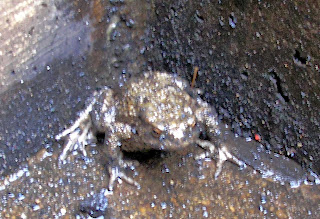Weds. 6th Nov
Gilbert attacked the ash pan, and Bruce initially offered help. The first task was to remove the damper door so that it could be used to verify the new-cut metal. This proved to be quite a challenge. Two chaps from the Loco Dept joined in and helped Gil. Fire bars had to be removed so that Gil could get inside the firebox, standing in the front section, leaning over where the axle passes beneath, and working (almost upside down) in the rear section. It was impossible to undo nuts & bolts, so Gil attacked them with an angle grinder.
The portable lamp threw a wobbly, as two wires decided they'd had enough of being bent. I examined the cable, and discovered that it had not been assembled "cleverly". It was easy enough to cut off the dead wire, thread the cable properly and re-assemble it.
3/4 the way through the last bolt, and Gil's angle grinder died. Raiding the Loco Dept tool store, he found another. Plugged it in ... no sign of life! Why do people put away dead tools, instead of informing someone and getting them fixed??? Gil found a third one, and that did work.
Meanwhile, I started cleaning rail chairs, but rain soon started. This results in the rust & oil combining into a brown soup on the chairs as the needle gun pounds the mixture into a paste. Also, Gilbert had nicked my angle grinder (see above) so I couldn't finish off the prep anyway. As the rain increased, I decided to give up.
Bruce had wisely moved inside and was painting chairs prepared last weekend. He could only spare the morning at Todders, and disappeared at lunchtime. I painted brushes until lunch. Thereafter, there was little I could do, so I went home, too. In a way, it was lucky that I did because a courier arrived at my house with new wire brush discs for us.
Fri. 8th
I did lettering on rail chairs and then dismantled our dead angle grinder. One of the carbon brushes had died. I located spares on t'internet and order a set.
Sat. 9th
Lots of people responded to my email asking for help for Gilbert, as he was supposed to be replacing the lower rear section of the ash pan and remove the cylinder valve pistons - these need to be completed by end November.
Because rain was threatened, I arrived early and attacked some GWR rail chairs, cleaning three before the rain set in leading to me making more soup.
David arrived did a bit of welding. Later, he made a short section of rod for the new position of the damper door. The door will be a couple of inches lower to make it easier to clear out ash. Needless to say, the existing rod then fouled some pipe work, so this by-pass had to be made to divert the rod round the pipe. Bruce, John G, John T, Geof soon followed. Despite the rain, most people started tackling the ash pan and valves. Fortunately, the rain stopped at lunchtime, which made it more pleasant to continue.
The rear damper door (that Gil managed to get off on Wednesday) was bent in the centre of the top edge. Because our ash pan had to be narrower than the original in order to accommodate the steam heating pipe (which was not fitted originally) the cast steel bracing piece from the original damper door had been cut through the middle. This formed a weak point, and the doors tended to bend down the centre line. So, Bruce & John T undid the nuts and bolts, and David subsequently welded up the centre. Meanwhile, Andy W [Loco Dept] got the gas out and tortured the door, beating it back into more-or-less straightness.
When Bruce was in the pit under the loco, he moved a ladder and discovered a toad hiding behind it. Feeling that the toad was truly in a hole (i.e. it couldn't climb out of the pit), I extricated it and deposited it in the hedge by the wood store - plenty of places for it to crawl and hide.
Removing the piston valves is one of those jobs that requires one to move half of the planet before being able to extract the valve rod. Several sections of running board had to come off. Then, at the rear end of the valve shaft, there is a taper that fits into a slidey-thing. A cotter pin secures the tapered end in the slidey thing, but getting the rod out was a minor challenge. You can't hit the end of the rod to free it. The only thing to do was disconnect it from the connecting rod. The connecting rod is secured to the slidey-thing (aka valve spindle cross-head) also with a tapered gudgeon pin, which has a castellated nut on the inside (not visible in the photo).
It took four of us to remove the pin, separate the parts, slide the valve rod in a bit, and then belt the end of it with a sledge hammer! I was a tad concerned, since it was I who was holding the brass drift against the rod end, while Geof was wielding the sledge hammer - frequently hitting the connecting rod and bouncing into the wheel. But we got there in the end!
During all of the excitement, John G was acting as general assistant and gopher; John T was undoing nuts & things in support of the valve removal. Underneath the loco, Gilbert was removing more bits of the lower ash pan, assisted by David at times, and Ray O'H [Loco Dept] and Andy W, with his gas bottles.
All in all, much fun was had, and many things achieved.
Roger





No comments:
Post a Comment